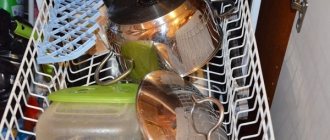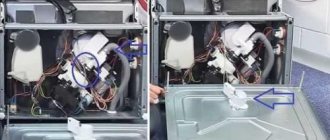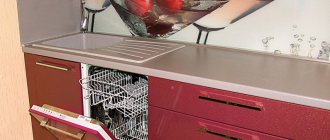During commercial breaks, the following words are heard more and more often from TV screens: “I’m a woman, not a dishwasher.” Therefore, many people began to think about buying a dishwasher for their kitchen. One of the most frequently chosen brands on the market is Bosch. Household appliances from this company have been used by many generations not only of Russians, but also of residents of the rest of the world. Even if you take a responsible approach to the selection and installation of this unit, thoroughly study all the instructions, indicators of the Bosch dishwasher and operating tips, you can still encounter minor or major problems in the operation of this equipment.
Description of controls
In everyday use, a Bosch dishwasher is unlikely to cause much difficulty in use. Many lights and modes remain unused. But to use a Bosch dishwasher comfortably, you need to know what each of the signal indicators means. Let us first consider those that are present on almost all models and indicate various stages of work.
- “End” indicator – indicates the end of the dishwashing cycle.
- “Brush” indicator – lights up when the dishwasher starts.
- “Tap” indicator – signals the period of operation when the cavity of the machine is filled with hot water.
- The “Salt” indicator (two arrows in the shape of the English letter S) - indicates the presence of a salt absorbent, which helps clean the heating element from scale that has formed on it.
- The “Rinse aid” indicator (snowflake, sun, star) indicates the presence of dishwashing liquid in a special compartment.
The keys responsible for setting and regulating the upcoming wash are allocated to a separate category. The functionality of each Bosch model is very different, so only those buttons that are most common will be described.
- “Pan” - this symbol indicates an intensive mode of washing dishes at a temperature of more than 70 degrees Celsius and lasting about an hour. Used for the heaviest stains.
- “Cup and saucers” (or Auto mode) is the standard operating mode. Similar to when we wash dishes by hand. Water temperature - 50 degrees. Duration – up to two hours.
- “Cup and plates” (ECO, economy) – mode of reduced water consumption. It differs from the standard one in the presence of a rinsing stage.
- “Glass (cup) with two arrows” – accelerated washing. It passes in half an hour at a temperature of about 40 degrees Celsius.
- “Glass” – delicate mode. Used for fragile dishes.
- “Baby food bottle” – treatment of dishes with hot water, which destroys germs. Used to disinfect baby supplies (dishes, pacifiers, etc.).
Designations of icons on typewriters of other brands
Dishwashers from other brands have approximately 70% of the same signs in the same interpretation as on BOSCH devices, but some differences are worth knowing:
- Ariston: pan icon with three lines - intensive wash, pan symbols with two stands - standard mode;
- Hansa: 3 in 1 - washing regular dirty dishes without dried food on them, black saucepan with a lid - intensive washing of especially dirty dishes with dried food residues;
- Siemens - cup and glass with arrows to the right - especially quick wash at 45 degrees, 30 minutes.
Electrolux dishwashers have fewer programs and their designation is typical of Ariston and Bosch. You can find out more information in the instructions for the dishwasher, where each operating mode is described in detail.
Subscribe to TechnoCouncil on social networks so you don’t miss anything:
Types of faults
Most problems that can occur with a Bosch dishwasher do not lead to its complete failure. Modern equipment is equipped with sensors that prevent them from starting if any part is in poor condition. The user will be notified of this either by flashing indicators or an error code on the display of the Bosch dishwasher.
Moreover, the exact startup error can only be determined by putting your dishwasher into service mode. To do this, you need to hold down a combination of some indicators on the panel, which is described in the instructions. Those signals that can be seen in normal mode give only an approximate indication of the problem.
Why does my dishwasher leak?
Leaking appliances are a common problem faced by dishwasher owners. It manifests itself in one of the following ways or both at the same time:
- Leaking from under the door. Water is leaking from underneath the dishwasher door.
- Aquastop works. Water leaks into the dishwasher tray, located below it. Because of this, the leakage protection system is activated and the drain pump is turned on.
Note! If the Aquastop leak protection has worked, then whenever you turn on the dishwasher, it will start the drain pump (you will hear its noise) and will stop responding to commands from the buttons or control sensor.
Moreover, in some machine models, the drain pump continues to work even if you turn off the dishwasher with the power button.
To avoid failure of the drain pump, we recommend that in such models you unplug the plug from the socket before calling a technician.
In this material we will explain in detail why a dishwasher leaks, whether this always indicates a malfunction, and what to do in case of a leak.
If you find a puddle of water under the PMM door or a leak from under it, do not rush to start repairs or call a technician. First, rule out the following reasons:
- In the built-in dishwasher, someone opened the door while drying dishes. There is a lot of steam in the drying cycle of the dishwasher. When you open the door, it comes out and condenses on the bottom edge of the countertop. Then, the drops flow down the door seal onto the floor, and a small puddle forms under the door. This is absolutely normal. To prevent this situation, do not open the machine until it has finished drying the dishes.
- The PMM is not set according to the level. The seal, which is located around the perimeter of the door, does not provide complete sealing of the washing chamber. It only protects against splashes and helps water flow back into the dishwasher. If the PMM is installed tilted forward, water may flow through the corners of the door from below. To eliminate a leak, you need to level the machine.
- Problems with detergents: poor quality, incorrect dosage (excess). Poor-quality washing products (tablets, rinse aids, powder), as well as their excess, can lead to increased foam formation. In this case, you will see not only water, but also foam on the floor. To avoid leaks, use dishwashing detergents recommended by the manufacturer of your dishwasher and strictly adhere to their quantities.
- Accumulation of detergents inside the PMM. Residues gradually accumulate inside the dishwasher, especially if you exceed the recommended dosage. This leads to increased foaming during operation of the machine, and foam and water come out of it. Run the empty machine through a long, high-temperature wash cycle to remove excess detergent.
- Clogged filters that purify the water circulating during washing from food residues. It also contributes to the formation of excessive amounts of foam in the dishwasher and its leakage at the corners of the door from below. Clean filters regularly to prevent trouble. Refer to your machine's owner's manual for cleaning instructions.
- The door seal of the built-in dishwasher is dirty. When dirt and food debris adhere to the seal, its seal will deteriorate. As a result, the door allows steam to pass through, which condenses on the lower edge of the countertop and flows onto the floor. It is necessary to wipe the seal with a sponge soaked in warm water. Do not use aggressive agents or rub too hard to avoid mechanical damage to the seal!
The above tips did not help, and your dishwasher continues to leak at the corners of the door? This means there is a malfunction. Here is a list of common breakdowns that can cause a leak.
*The table shows the cost of the master’s work only. If repairs require spare parts, they will be charged additionally.
Under the dishwasher there is a tray with a float sensor. When water gets there, the float floats up, the leakage sensor is triggered, the machine shuts off the water supply and turns on the drain pump.
The dishwasher usually reports that the Aquastop has worked with an error code that lights up on the display or flashes as a combination of indicators (if the machine does not have a screen). Here are the Aquastop error codes depending on the PMM brand.
- Turn off the PMM. Press the on/off button and then remove the plug from the outlet.
- Remove water from the pan. To do this, pull out the machine and tilt it slightly towards you. Alternatively, remove the side of the dishwasher and wipe off the water in the tray with a rag.
- Make sure it is the dishwasher that is leaking.
Plug in the machine and start the program again. While washing, observe the operation of the machine and the surrounding plumbing (if it is leaking!). If Aquastop works again, then you need to look for a leak in the machine itself. Did the wash go without any problems? This means that water got into the pan for some external reason: regular (for example, a sewer leak) or one-time (for example, a child spilled water on the floor next to the car).
READ MORE: If the LED lamp begins to shine dimly
Note! If the leakage protection system in the dishwasher is activated, but there is no water in the tray, this indicates a malfunction of the Aquastop sensor or control unit. For more details, see the breakdown table below.
Turning on Aquastop does not always signal a leakage of equipment, much less a breakdown. Here is a list of reasons why the leakage protection system is triggered, which are easy to fix yourself.
- There is a leak in the utilities surrounding the dishwasher. Often PMM has nothing to do with it, but sewerage, plumbing, and pipe connections are leaking. Water from utility leaks is poured into the pan and activates Aquastop. Or there have been cases when housewives spilled water on the countertop under which the dishwasher stood; the moisture flowed through the joints of the countertop into the tray and triggered the leakage protection system.
- Clogged filters. If the filters are dirty, the water does not circulate well during washing and overflow may occur in the washing tank. As a result, the Aquastop system is activated. Clogged filters must be cleaned according to the instructions for your dishwasher. Moreover, equipment manufacturers recommend checking the condition of the filters after each dishwashing. If you don't, now is the time to start. Also, before loading the dishwasher, clear the dishes of large food debris, this will prevent the filters from clogging.
- Detergents not intended for dishwasher use. Often, inexperienced PMM users use compositions for manual dishwashing (for example, Fairy). This leads to the formation of a very large amount of foam. It climbs out of the dishwasher along with the water, gets into the tray, and Aquastop works. If you encounter such a situation, turn off the PMM as soon as possible and unplug the cord from the outlet. Then drain the water from the pan and wait a day or two for everything to dry. If after drying the machine does not start washing dishes, most likely the electronics have flooded - the control unit has failed and requires repair or replacement.
- The sink siphon to which the machine drain is connected is clogged. If you use a dishwasher and sink at the same time with a clogged siphon, water from the overfilled siphon will flow into the dishwasher and create an overflow. To fix the problem, drain the water from the PMM tray and clean the sink siphon. To prevent water from the siphon from entering the dishwasher, install a check valve on the dishwasher drain hose or connect the machine directly to the sewer.
Have you tried everything, but the dishwasher still activates Aquastop and reports a leak? It looks like you have a malfunction that requires the intervention of a technician.
Three classes of malfunctions lead to Aquastop operation:
- internal leaks of the dishwasher (connections of pipes and hoses, washing chamber, etc. leak directly into the tray);
- external leaks, when their scale is large enough (for example, a damaged drain hose or dishwasher door flows onto the floor, and water flows from the floor into the pan);
- failure of the leakage protection system itself or the electronics associated with it.
Each of the faults is discussed in detail in the table below.
*The price indicated is only for the work of the master. If repairs require spare parts, they will be charged separately.
As you can see, there are many reasons for leaks in a dishwasher, and figuring out which unit is leaking on your own is not so easy. A RemBytTech service engineer will help return life to normal: a technician will arrive within 24 hours, detect and repair the leak, and after repair will give a guarantee of up to 2 years.
7 (495) 215 – 14 – 41
7 (903) 722 – 17 – 03
Or submit an online application at any time.
"RemBytTech" - we repair dishwashers of any brand and year of manufacture. Contact us!
Types of errors on devices without a digital display
This type of error is not standardized, so this section will look at some options for displaying it on various panels. In order to find out how to eliminate them, a digital code (for example, E4) will be given at the end, which will be deciphered in the next section. We remind you, do not forget to put your Bosch dishwasher into service mode.
A panel that displays up to three digits:
- 0 - No problem;
- 1 – faulty water supply indicator (E6);
- 2 – error in the water heating system (E01);
- 4 – the reservoir is not filled (E3);
- 8 – breakdown of the thermometer (E2);
- 16 – malfunction of the flow regulator (E4).
Panel (display) with two lines:
- S3 – no problems found;
- A or B – error in receiving data from the aqua sensor (E6);
- E – no signal is received from the flow switch (E4);
- F – water does not enter the working cavity (E3);
- G – flow switch does not stop (E5);
- H – problems with the heating element (E01);
- K – short circuit or wiring fault (E2).
Types of errors on devices with a digital display
Most modern Bosch dishwashers are equipped with such digital panels. Error indicators will light up on them if the dishwashing process failed to start. This facilitates the diagnostic process, and therefore the speed of repair. It is highly not recommended to repair such complex equipment yourself. Contact the appropriate service center. We remind you, do not forget to put your Bosch dishwasher into service mode.
- Uniform flashing of all indicators – software failure;
- E01 – control unit failure;
- E1, F1 – sensor malfunctions;
- E02 – wiring break;
- E2, F2 – heating errors;
- E03 – drying does not occur;
- E3, F3 – tank is not filled;
- E04 – see E02;
- E4, F4 – malfunction of the spray mechanism;
- E05 – see E01;
- E5, F5 – leakage or overflow of the tank;
- E06 – the chamber is not sealed (problems with the locking mechanism);
- E6, F6 – failure of the incoming water quality sensor;
- E07 – fan failure;
- E7, F7 – drain pipe clogged;
- E8, F8, E08 – low water level;
- E9, F9, E09 – problems with power supply to the heating system;
- E10, F10 – see E03, E07;
- E11, F11 – no data from the temperature sensor;
- E12, F12 – contamination of the heating element with limescale;
- E13, F13 – incoming water temperature is too high;
- E14, F14 – error in the water distribution system;
- E15, F15 – tank leak;
- E16, F16 – valve leakage;
- E17, F17 – the incoming water pressure is too powerful;
- E18, F18 – see E3, E14;
- E19, F19 – malfunction in the system;
- E20, F20 – problems with the pump;
- E21, F21 – see E3, E20;
- E22, F22 – drain system clogged;
- E23, F23 – breakdown of the pump responsible for removing water from the tank;
- E24, F24, E25, F25 – see E22;
- E26, F26 – flow sensor failure;
- E27, F27 – problems with the electrical network;
- E28, F28 – see E6;
- E29, E30, F29, F30 – see E27.











